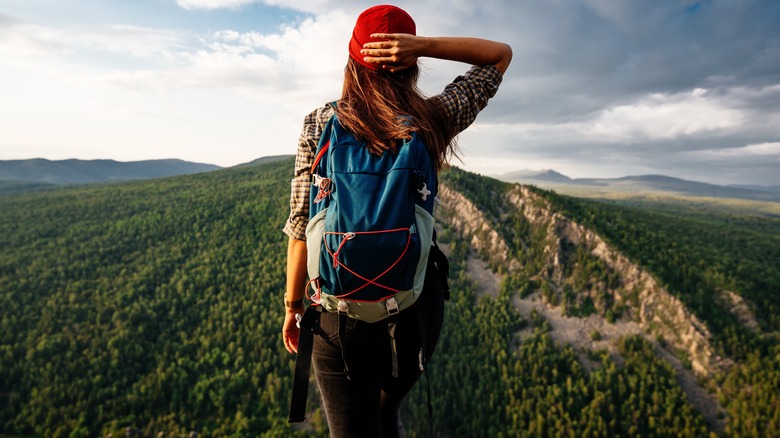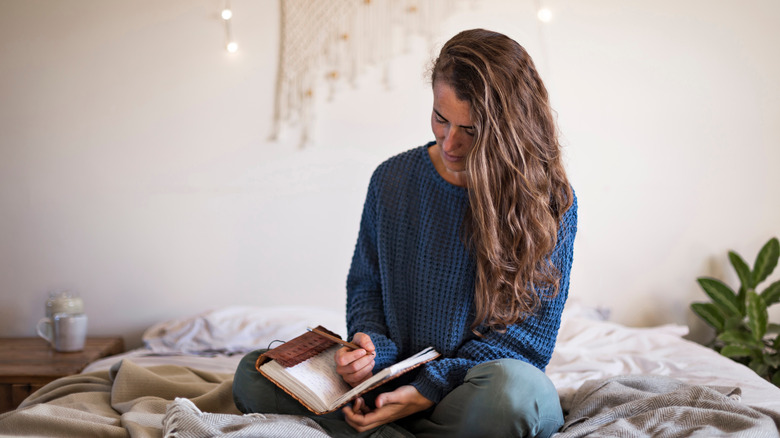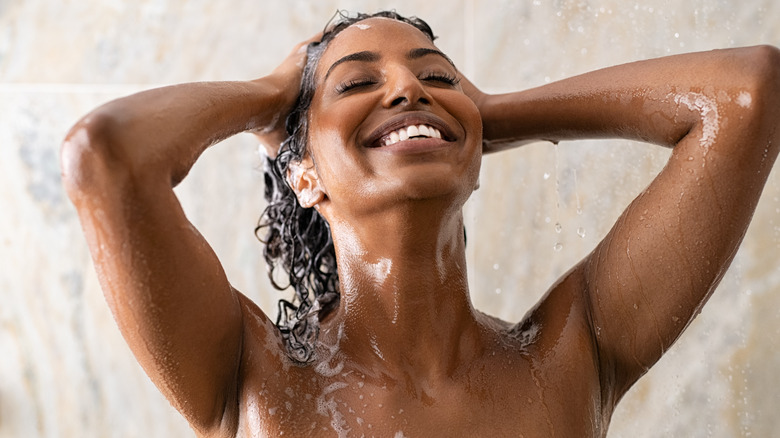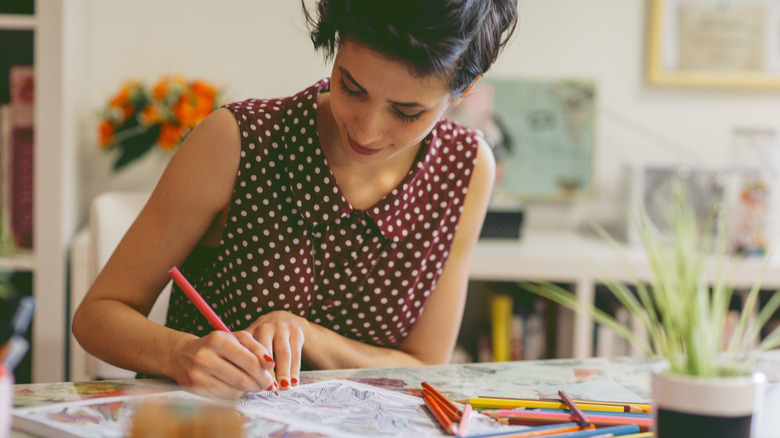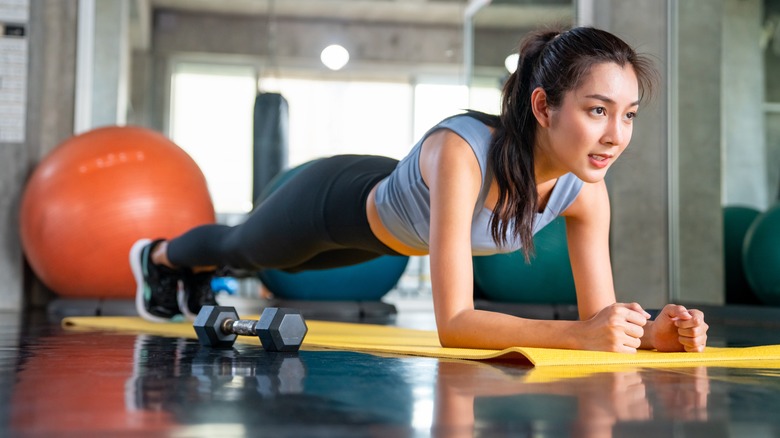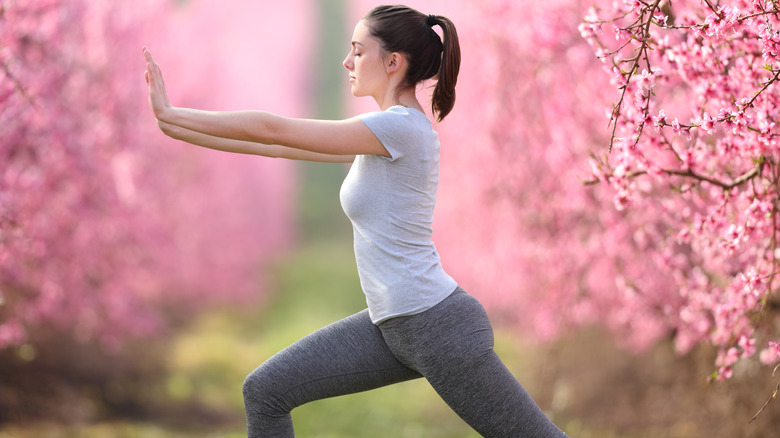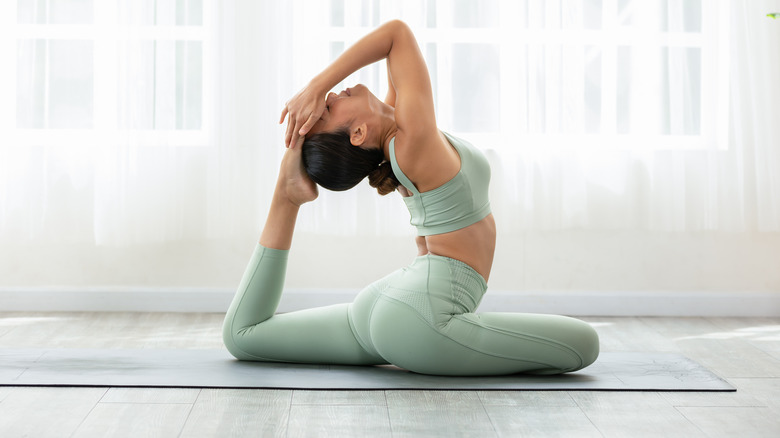9 Meditation Alternatives To Help You Embrace Mindfulness And Ease Stress
The trending wellness industry is once again in full swing, and it's not just sea moss, green powders, and Gwyneth Paltrow's vagina-scented candles. Meditation and mindfulness are buzzwords that have been popular for years now, yet many people are wary about the idea of sitting crisscross apple sauce in a silent room where their thoughts might potentially wander to the time they wet their pants in front of the whole class in third grade. Basically, some might feel intimidated by meditation because it could bring about certain thoughts, feelings, or memories, sans any type of outside interference ... and confronting those things can be unsettling.
According to a 2017 study published in PLOS ONE, formal meditation can even sometimes have adverse side effects, like hyperarousal (anxiety, irritability, or fear) and hypersensitivity to light or noises. VICE interviewed several people who had bad experiences with it, like one person who told the publication that after building up to a twice-daily meditation habit of 60 minutes per session, "I was becoming withdrawn. I started to lose interest in life a bit."
Thankfully, there are many alternatives to a silent meditation practice, including activities that can get you into a flow state. This can be a more active meditation, in which you're engaged in an activity you do subconsciously while allowing your thoughts to wander. If meditation isn't for you, we've got you. Here are some other ways to embrace mindfulness and ease stress.
Do 'morning pages' or free write
Picture this: the sun is rising, and you've just woken up. It's the perfect time to grab your favorite journal and a trusty pen. As you start to write, the words flow freely, without judgment or filters. As you pour out your thoughts, dreams, worries, and anything else that comes to mind, it feels as if you're having a conversation with your own soul.
"The Artist's Way" by Julia Cameron was published way back in 1992, and yet it still has as much relevance today as it did then, if not more. Cameron's book takes readers through a 12-week course on creativity, with one of the tasks being Morning Pages. This process can feel incredibly liberating as you let go of the weight you've been carrying, allowing your thoughts to unfurl and find their rightful place on paper. It's a cathartic experience, releasing emotions and untangling the knots in your mind. And the best part? There's no right or wrong way to do it; the only rules are that you can't show them to anyone else or reread them later, which definitely sends your inner critic packed up and going on a long trip to Maui.
Morning Pages can be a form of meditation, in that you center yourself and cultivate mindfulness. As you engage in this daily ritual, you bring your attention to the present moment. You become aware of the words flowing from your pen, the rhythm of your breath, and the sensations in your body.
Take a shower or clean the house while listening to music
Have you ever noticed how taking a refreshing shower or getting into a cleaning spree can transport you to a blissful flow? These seemingly mundane activities can be just as meditative as sitting cross-legged on a cushion. In a 2015 study published by the Journal of Creative Behavior, 1,114 people responded to an online questionnaire with results showing some significant themes for when they get their best insights: Showering or exercising were common.
Imagine stepping into a warm, soothing shower, and as the water cascades over your body, your mind starts to relax. The rhythm of the water droplets hitting your skin becomes a calming mantra, washing away the stress of the day. You focus on the sensations — the scent of your favorite soap, the gentle massage of lathering up. It's a moment of pure indulgence, where you are fully present in the here and now. You might find yourself solving a problem that has been nagging at you or experiencing a burst of inspiration for that project you've been working on.
The same can be said of putting on your favorite playlist and tidying up your house. As you dust, sweep, and declutter, your mind enters a state of focused concentration, becoming absorbed in the task at hand, almost like a moving meditation. And who doesn't want to lip sync Whitney Houston songs into their broom? It makes cleaning a lot more fun!
Try free-form dancing
We all know that dancing can make us feel alive and joyful, though some of us prefer sitting at the bar and bobbing our heads to the beat unless we're in the privacy of our own homes. Free-form dance (or conscious dance) is a liberating form of self-expression, in which you have the freedom to move your body in any way that feels natural and authentic to you. It's a space where you can let go of inhibitions, release pent-up emotions, and express yourself without judgment. Dancing can also have a profound impact on our mental and emotional well-being.
In a 2021 study published in an issue of the Complementary Therapies in Clinical Practice, 1,000 dancers were surveyed who participated in free, unchoreographed dancing, with 99% claiming they felt more present in their bodies, and 93% saying they felt like they were in a flow. Of the participants who experienced anxiety or depression, 96% said free-form dancing had a therapeutic effect.
Group classes can be found in several areas and even online, usually under the name "ecstatic dance," where you're invited to unleash your inner wild spirit and dance in a group. It's a liberating experience where the music becomes your guide — there are no rules or judgments, only pure freedom. It's a sacred space where you can connect with yourself, dancing in any way you please. Thus, you are safe from risking any eye rolls and weird looks at the club.
Walking outdoors whether it's on a beach or in the forest
Lacing up your sneakers and heading out on a stroll under the trees has always been considered a calming experience (unless you're really not into bugs), and it can also have several mental health benefits. As we step onto the earth, surrounded by towering trees, flowing streams, and the gentle caress of the breeze, we enter a state of tranquility and connection. Nature has a remarkable way of grounding us and bringing us into the present moment. As we walk, our senses awaken to a symphony of sounds — rustling leaves, a dog barking in the distance, our feet hitting the dirt. In this state of mindfulness, our minds might get quiet, and the worries about phone bills or that weird clink in the car melt away.
The act of walking becomes a meditation in motion; our minds become clear and receptive. Insights and inspirations may flow effortlessly; we can ask ourselves meaningful questions, gain perspective, and find answers within. In a 2020 study published in the Journal of Environment and Behavior, researchers asked participants to do one of three activities for 40 minutes during a stressful period: walk in nature, watch a video of a nature scene, or walk on a treadmill. The study concluded that those who walked in nature had significantly lower cortisol levels (the stress hormone) than those who had just watched a video.
If you prefer something guided, the Simple Habit app has a walking meditation called "Sensations and Surroundings."
Use an adult coloring book or paint by numbers
In kindergarten, coloring was simply one of our many play activities, just like jumping rope or hopscotch. But more recently, coloring for adults has become a hot trend, with books covered in intricate designs sold everywhere. When we begin coloring, our focus shifts from the chaos of everyday life to the simplicity of staying inside the lines. As we carefully choose colors and bring life to the images on the page, we can enter a state of flow — where time seems to melt away, and we become thoroughly engrossed in the present moment. Paint by numbers can have a similar effect. The repetitive motions of coloring or painting can be incredibly soothing, like a gentle form of meditation, and provide therapeutic benefits like stress relief and anxiety reduction.
In a 2005 study published in the Journal of the American Art Therapy Association, 84 undergrad students received an anxiety induction and were then asked to either color designs or on a blank piece of paper. Those in the former group had reduced levels of anxiety, while those in the latter saw no relief. According to researchers, one reason for this could be that the designs required more attention, but the low level of difficulty didn't require much focus.
Adult coloring books and paint by numbers also provide a respite from technology and screens. In a world filled with constant notifications and distractions, coloring allows us to unplug and reconnect with ourselves. It's a screen-free activity that promotes mindfulness and helps us find balance in our digital-centric lives.
Hit the gym
Ask any athlete and they will likely wholeheartedly agree that exercise for them is like a form of meditation. When we engage in physical activity, such as lifting weights or running, our focus shifts from the external world to the sensations within our bodies. We become fully present in the here and now, attuning ourselves to the rhythm of our breath, the movement of our muscles, and the beat of our hearts. William Fowler, head of content programming at Headspace, told Bustle, "By calling full attention to your workout instead of the stress of everyday life, you're giving yourself more of a chance to engage with your body's movement and boost your mood while giving your brain a well-deserved break."
The act of sitting in silence and trying to meditate can be jarring for some, whether it's that itch on your nose that won't seem to go away or your sweater feeling too tight. Thus, many people find solace in different types of moving meditation, such as free dance or walking in nature, as previously mentioned. According to Lifestyle Solutions Medspa, physical activity gives you the same benefits as meditation. While exercising, the brain's alpha and gamma waves increase, leading to increased mental clarity and lower levels of cortisol.
Does the idea of a sweaty gym full of grunting men and loud machines sound like the opposite of meditation? Cali Estes, a psychologist and personal trainer, told the Chicago Tribune, "Meditation can be achieved in the middle of Times Square," noting that it's simply about letting go of any unwanted or negative thoughts.
Have sex
Orgasmic meditation is actually a thing, believe it or not, and despite the name, the goal is simply to let go and feel the sensations in your body rather than an orgasm itself. OM is a partnered practice that focuses on creating a safe space for intentional, non-goal-oriented touch. It involves the gentle and precise stimulation of the clitoris for a specific period of time. The purpose is not solely to achieve orgasm but to cultivate heightened states of awareness, connection, and pleasure.
Similar to other forms of meditation, OM is a practice of mindfulness and presence. It requires us to cultivate awareness of our bodies, sensations, and emotions without judgment or expectation. By fully indulging ourselves in the experience, we can tap into the transformative power of the present moment and unlock a deeper connection with ourselves and our partners.
Anjuli Ayer, CEO of the Institute of OM, told Healthline, "OM is a meditation in connection. It merges the power of meditation with the experience of being in an orgasmic state." But is it really meditation? Hindu meditation guru Shree Ramananda noted, "All meditation counts as meditation. Meditation is simply a method to connect with your true self. Or rather, a way to escape the character/roles we often confuse ourselves to be."
Get into Tai Chi
In the fast-paced world we live in, finding moments of tranquility and inner peace is essential for our well-being. Enter Tai Chi, a beautiful practice that blends gentle movements, mindfulness, and meditation. Tai Chi, originating from ancient China, is a martial art that has evolved into a graceful and flowing form of exercise and meditation. It combines slow, deliberate movements with focused breathing and mindful awareness. As we engage in gentle, fluid movements, our attention is drawn to the sensations of our bodies, the alignment of our posture, and the rhythm of our breath. Tai Chi invites us to become fully present, connecting our mind, body, and spirit.
Each movement is performed with deliberate intention and conscious awareness. As we focus on the intricate details of the postures, the sensations in our bodies, and the subtleties of our breath, we anchor ourselves in the present and develop a deeper connection with ourselves. According to the Susan Samueli Integrative Health Institute, Tai Chi has numerous health benefits, including increased physical well-being, help with depression, and improved sleep.
Practice yoga
Yoga is a holistic practice that nourishes both the mind and body. Through the combination of physical postures, breathwork, and meditation, yoga becomes a transformative journey of self-exploration and inner growth. The poses, or asanas, help strengthen and tone our bodies, while also improving flexibility and posture. The conscious breathing techniques (pranayama) calm the mind, reduce stress, and promote mental clarity. Through meditation — aka dhyana — we find a space of stillness and self-reflection, fostering emotional well-being and a deep connection with ourselves. And listen, putting yoga on a list of silent meditation alternatives might seem a bit stereotypical, but the two are like peanut butter and jelly, or macaroni and cheese, they just fit.
Natalie Nevins, DO, a board-certified osteopathic family physician and certified Kundalini Yoga instructor, told the American Osteopathic Association, "Regular yoga practice creates mental clarity and calmness; increases body awareness; relieves chronic stress patterns; relaxes the mind; centers attention; and sharpens concentration."
It becomes a tool, then, for navigating the challenges of life and embracing our authentic selves. Yoga encourages us to break free from limitations, let go of self-doubt, and step into our true potential. Yoga can be transformative, inviting people to embrace their bodies, nurture their minds, and awaken their spirits.
